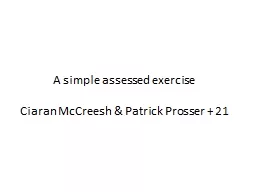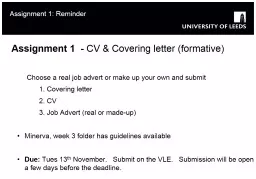PPT-A simple assessed exercise
Author : olivia-moreira | Published Date : 2017-09-23
Ciaran McCreesh amp Patrick Prosser 21 Simple assessed exercise 10 credit course 10 weeks 30 lectures Equivalent to 100 hours in total 30 lectures 20 coursework
Presentation Embed Code
Download Presentation
Download Presentation The PPT/PDF document "A simple assessed exercise" is the property of its rightful owner. Permission is granted to download and print the materials on this website for personal, non-commercial use only, and to display it on your personal computer provided you do not modify the materials and that you retain all copyright notices contained in the materials. By downloading content from our website, you accept the terms of this agreement.
A simple assessed exercise: Transcript
Download Rules Of Document
"A simple assessed exercise"The content belongs to its owner. You may download and print it for personal use, without modification, and keep all copyright notices. By downloading, you agree to these terms.
Related Documents














